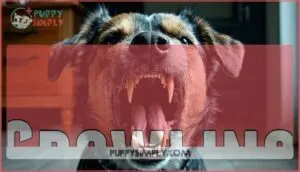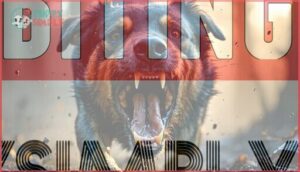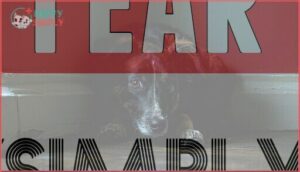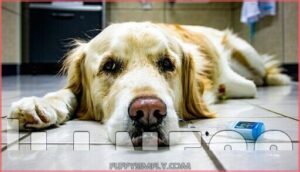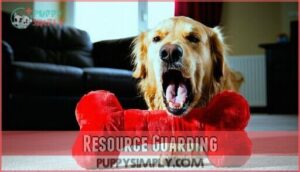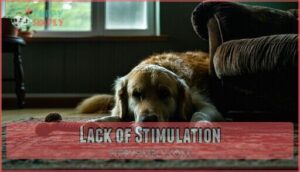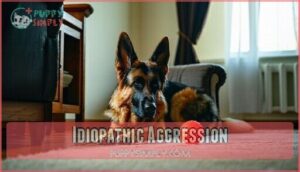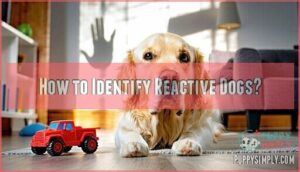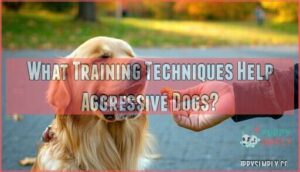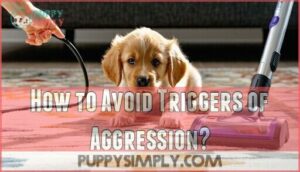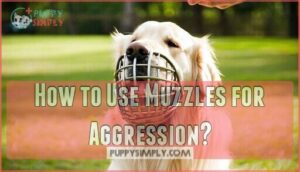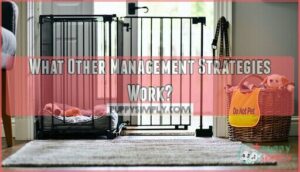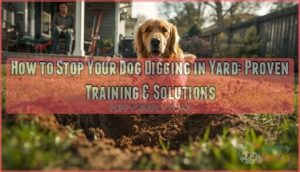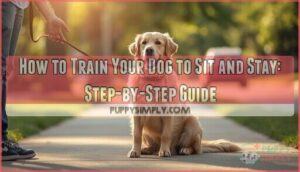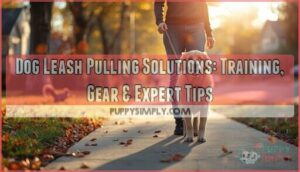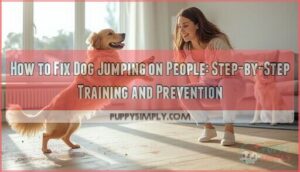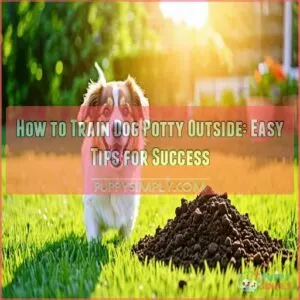This site is supported by our readers. We may earn a commission, at no cost to you, if you purchase through links.
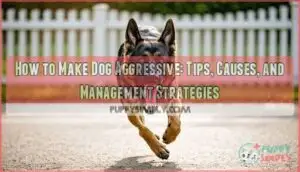
Instead, I’ll address what you might actually be looking for. If you’re concerned about your dog’s lack of protective instincts, understand that most dogs naturally alert to strangers without training.
Proper socialization and basic obedience training create confident, well-balanced dogs who’ll protect their families when truly needed. Dogs become aggressive due to fear, anxiety, poor socialization, or medical issues – not intentional training.
These behaviors create liability risks and suffering for the animal. If you need home security, consider professional security systems or consult a certified dog trainer about appropriate protection training that doesn’t involve creating aggression.
Understanding the difference between protection and aggression reveals better solutions for your specific concerns.
Table Of Contents
- Key Takeaways
- What is Aggression in Dogs?
- How Do Dogs Show Aggression?
- What Causes Aggression in Dogs?
- How to Identify Reactive Dogs?
- What Training Techniques Help Aggressive Dogs?
- How to Avoid Triggers of Aggression?
- How to Keep a Dog Journal?
- How to Use Muzzles for Aggression?
- What Other Management Strategies Work?
- What Should I Avoid Doing When Training Aggressive Dogs?
- Frequently Asked Questions (FAQs)
- Why is my dog so aggressive?
- How to help people with their aggressive dogs?
- How do I Stop my Dog from being aggressive?
- Is my dog aggressive toward other dogs?
- How can my dog be aggressive?
- How to make your dog fearless and aggressive?
- How can aggression be prevented in dogs?
- What are the signs of aggression in dogs?
- Are there any home remedies for aggression in dogs?
- Are there any medications that can help with aggression in dogs?
- Conclusion
Key Takeaways
- You shouldn’t train dogs to be aggressive—it creates dangerous situations, legal liability, and animal suffering while proper protection training focuses on confidence-building instead.
- You’ll recognize aggression through warning signs like growling, stiff posture, raised hackles, and intense staring, which stem from fear, anxiety, medical issues, or lack of stimulation rather than intentional training.
- You can manage aggressive behavior through desensitization training, positive reinforcement, environmental controls like gates and crates, and "Do Not Pet" gear while avoiding punishment methods that worsen the problem.
- You need professional help from certified trainers and veterinary behaviorists who’ll address underlying causes through proper socialization, consistent training, and sometimes medication rather than trying to create aggression.
What is Aggression in Dogs?
Aggression in dogs isn’t just about growling or biting—it’s their way of signaling discomfort or distress.
Canine aggression often stems from fear, anxiety, or frustration, and it’s important to recognize the early signs, like tense posture or intense staring.
Normal behavior differs by breed, as some are naturally more protective.
Understanding aggression types, including resource guarding or territorial instincts, helps manage responses effectively.
Always stay calm, set clear boundaries, and use training to address canine aggression while building trust and ensuring safety.
How Do Dogs Show Aggression?
You’ll notice aggressive dogs display warning signs before they escalate to more serious behaviors. These signs include growling, lunging forward, and ultimately biting when they feel threatened or stressed.
Growling
Growling serves as your dog’s primary warning system before aggression escalates. Think of it as a yellow traffic light – it’s telling you to proceed with caution. Understanding growl intensity helps you gauge the situation’s severity. A low rumble differs substantially from a sharp, high-pitched growl that signals immediate danger.
Never silence your dog’s growl—it’s their way of saying "I need space" before things escalate.
Context matters when interpreting these vocalizations:
- Resource guarding growls occur around food, toys, or sleeping areas
- Fear-based growls happen when dogs feel cornered or threatened
- Territorial growls emerge when strangers approach your property
Suppressing growls through punishment creates a dangerous situation. You’re removing your dog’s early warning system, making bites more likely without notice. Early growls provide valuable information about your dog’s emotional state. Preventing escalation requires addressing the underlying cause rather than silencing the symptom.
Never punish growling behavior. Instead, identify triggers and work on building your dog’s confidence through proper dog training and positive reinforcement techniques.
Lunging
While growling serves as your dog’s warning system, lunging takes aggressive behavior to the next level. This sudden forward movement often catches owners off guard and can escalate situations quickly.
Understanding Lunge Triggers and Prevention
| Trigger Type | Common Scenarios | Prevention Strategy |
|---|---|---|
| Fear-based | Strangers approaching | Distance Management techniques |
| Resource guarding | Food/toy protection | Redirecting Lunging behavior |
| Territorial | Doorbell/visitors | Leash Reactivity training |
| Overstimulation | Crowded areas | Environmental control |
| Pain/illness | Being touched | Veterinary evaluation |
Leash Reactivity commonly involves lunging toward other dogs or people. Your dog’s body language typically shows stiff posture, raised hackles, and intense staring before the lunge occurs.
Lunge Prevention starts with recognizing these warning signs early. Distance Management helps you maintain space between your dog and triggers. When you spot potential triggers, create more distance immediately.
Dog aggression training focuses on teaching alternative behaviors. Instead of lunging, redirect your dog’s attention to you through commands or treats. This canine aggression causes require consistent dog behavior modification approaches for lasting results.
Biting
Dog bites represent the most serious form of canine aggression, often causing lasting physical and emotional damage.
Understanding bite severity helps you recognize warning signs before attacks occur. Common biting triggers include fear, pain, resource guarding, and territorial behavior.
Bite prevention starts with proper puppy biting training and early socialization. When dogs show aggressive tendencies, immediate intervention prevents escalation to dangerous dog attacks.
Professional biting rehabilitation programs address underlying causes while teaching bite inhibition. Never ignore early aggression signs – they’re your warning system before serious dog bite incidents happen, as they can lead to lasting physical and emotional damage, and understanding canine aggression is key.
What Causes Aggression in Dogs?
Understanding what triggers aggressive behavior in your dog is the first step toward managing and preventing it.
Several factors can cause dogs to become aggressive, including fear, anxiety, illness, resource guarding, lack of mental stimulation, and in rare cases, idiopathic aggression with no clear cause.
Fear
When your dog’s world feels unsafe, fear becomes the driving force behind aggressive responses.
When fear takes the wheel, your dog’s aggression becomes their shield against an uncertain world.
Fear Triggers like loud noises or unfamiliar people can spark defensive reactions. Traumatic experiences create lasting impacts through Fear Generalization, where dogs associate similar situations with danger.
You’ll notice Calming Signals like lip licking or yawning before aggression escalates. Learned Helplessness develops when dogs feel trapped with no escape.
Focus on Confidence Building through positive dog training experiences. Understanding your dog’s fear responses helps prevent dog aggression before it starts.
Anxiety
While fear creates immediate reactions, anxiety builds up over time and can make your dog feel constantly on edge.
Separation Anxiety happens when dogs panic about being left alone, leading to destructive or aggressive behaviors.
Noise Sensitivity makes dogs react strongly to sounds like thunderstorms or fireworks.
Social Anxiety appears when your dog struggles around new people or situations they can’t control.
Generalized Anxiety affects dogs who worry about everything, creating a baseline stress that makes aggression more likely.
You’ll notice anxious dogs pacing, panting excessively, or showing repetitive behaviors.
These stressed states lower their tolerance for normal situations.
Dog training should focus on building confidence rather than suppressing symptoms.
Medication Options from your vet can help reduce anxiety levels.
Creating predictable routines and safe spaces helps anxious dogs feel more secure and less likely to react aggressively, by providing a sense of security and reducing stress, which can lead to aggression and requires professional help.
Illness
When your dog suddenly turns snappy, illness might be pulling the strings behind the scenes.
Pain aggression ranks as one of the most common dog aggression causes, transforming gentle pets into defensive biters.
Thyroid issues can make dogs irritable and unpredictable, while neurological disorders scramble their normal responses.
Cognitive decline in senior dogs creates confusion that triggers aggressive outbursts.
Even medication side-effects can flip your dog’s personality switch.
These dog medical issues require immediate veterinary attention because behavioral training won’t fix physical problems.
Your vet can identify hidden pain, illness aggression triggers, and dog health conditions that masquerade as behavioral issues.
It is crucial to address these issues promptly to ensure the well-being of your dog, as they can have a significant impact on its behavior and quality of life, and may be related to thyroid issues or cognitive decline.
Resource Guarding
Your dog’s treasured possessions can turn into battlegrounds.
Resource guarding happens when dogs become possessive over food, toys, or space they consider valuable.
Food Bowl Aggression emerges during mealtime, while Toy Possession creates conflict over favorite items.
Space Protection occurs when dogs claim specific areas like beds or doorways.
Multi-Dog Households face increased challenges as competition intensifies between pets.
This dog behavior stems from natural survival instincts but becomes problematic in domestic settings.
Prevention Strategies include teaching "drop it" commands early and avoiding punishment during possession episodes.
Understanding these dog aggression causes helps you address resource guarding through proper dog training techniques.
Lack of Stimulation
You might wonder why your usually calm dog suddenly snaps at family members or destroys furniture.
Lack of stimulation creates a perfect storm for boredom aggression, turning your pet into a frustrated bundle of energy with nowhere to go.
When dogs don’t get enough physical exercise or mental enrichment, they’ll find their own ways to release pent-up energy—often through destructive or aggressive behaviors.
Social isolation makes this worse.
Dogs are pack animals who need interaction and engagement.
Without proper outlets, their natural dog instincts become misdirected, leading to serious dog behavior problems that create ongoing dog training challenges.
Consider these stimulation strategies:
- Toy rotation: Switch toys weekly to maintain novelty and interest
- Interactive feeding: Use puzzle feeders or hide treats around your home
- Daily exercise: Provide at least 30-60 minutes of physical activity based on your dog’s exercise needs
Proper stimulation prevents many dog aggression issues before they start.
Idiopathic Aggression
Sometimes aggression strikes without warning or clear reason.
Idiopathic aggression represents the mystery cases where diagnosis challenges even experienced veterinarians and behaviorists.
This unpredictable dog behavior often stems from genetic factors or brain chemistry imbalances that research advancements are still working to understand.
Treatment options remain limited, making prevention essential.
You’ll need extensive owner support and professional guidance to manage these situations safely.
Unlike other forms of dog aggression, idiopathic cases require lifelong vigilance since triggers remain unknown, making dog training and preventing dog attacks more complex.
How to Identify Reactive Dogs?
Spotting a reactive dog starts with recognizing early signs. Dogs react to triggers like unfamiliar people or loud noises, but understanding their body language is essential.
Look for lip licking, ears pinned back, or tail tucked—these show stress. Keep track of reactions to environments with a journal.
To manage reactivity:
- Identify dog aggression triggers like trigger stacking.
- Watch thresholds to avoid pushing too far.
- Learn dog body language to predict behavior.
- Use calm, planned behavior training.
This builds safety and control!
What Training Techniques Help Aggressive Dogs?
You can help your aggressive dog through proven training methods that focus on changing their emotional response to triggers.
These techniques require patience and consistency, but they’ll gradually teach your dog to stay calm in situations that once made them reactive, using changing their emotional response.
Desensitization
Once you’ve identified your dog’s reactive patterns, desensitization becomes your most powerful tool for changing aggressive behavior.
This dog training method works by exposing your pet to triggers at very low intensity levels, then gradually increasing exposure over time.
Start with trigger identification – pinpoint exactly what sets your dog off. Create a safe space where your dog feels secure during training sessions.
Begin below your dog’s reaction threshold, where they notice the trigger but don’t react aggressively.
Gradual exposure is key. If your dog reacts to strangers, start with people at a distance where your dog stays calm. Reward this calm behavior, creating positive association with the trigger.
Over several weeks, slowly decrease the distance as your dog remains relaxed.
Counter conditioning pairs this exposure with good things like treats or play. This dog behavior modification technique changes your dog’s emotional response from negative to neutral or positive.
Professional guidance helps guarantee you don’t accidentally worsen dog aggression triggers through improper timing or intensity.
Comprehensive Approach
Success with aggressive dog behavior requires holistic strategies that combine multiple techniques.
An integrated plan works better than single methods because dog aggression has complex roots.
Professional collaboration with certified trainers guarantees you’re addressing all aspects safely.
Your multimodal therapy approach should include:
- Desensitization training paired with positive reinforcement
- Environmental management using crates, gates, and muzzles
- Behavioral tracking through detailed journals
Consistent application of dog aggression solutions takes patience, but this thorough method gives you control over your dog’s progress while keeping everyone safe.
How to Avoid Triggers of Aggression?
Prevention remains your strongest weapon against dog aggression triggers.
Understanding your dog’s specific stressors helps you create a safer environment for everyone involved.
- Early Socialization during puppyhood builds confidence and reduces fear-based reactions
- Safe Spaces like quiet rooms give your dog retreat options when overwhelmed
- Read Body Language to spot tension before it escalates into aggressive behavior
- Positive Reinforcement rewards calm responses to potential triggers
- Consistent Training strengthens your dog’s impulse control and response reliability
Effective dog aggression prevention requires ongoing dog behavior observation and proactive dog training tips implementation.
How to Keep a Dog Journal?
Tracking your dog’s behavior becomes your roadmap to understanding aggression patterns.
A detailed journal helps you spot what sets your pup off and measure your dog training progress over time.
Here’s what to record in your behavior log:
- Date and time – Note when incidents happen
- Specific triggers – What sparked the reaction
- Environmental factors – Location, weather, nearby distractions
- Training progress – How your dog responded to commands
- Medication effects – Any changes after vet-prescribed treatments
This tracking system reveals behavior patterns and dietary impact on your dog’s reactions.
How to Use Muzzles for Aggression?
Muzzles serve as your safety net when managing dog aggression. They prevent bites while allowing controlled public outings.
Start muzzle training gradually with positive association techniques – let your dog sniff and investigate before fitting.
Here’s your step-by-step approach:
- Choose proper muzzle types – basket muzzles allow panting and drinking
- Confirm proper fit – two fingers should fit between muzzle and snout
- Create positive association – offer treats through muzzle openings initially
- Practice safe introduction – start with short sessions, gradually increasing duration
Selecting from various dog muzzle options guarantees a comfortable and effective fit.
Professional guidance enhances your dog safety strategy.
What Other Management Strategies Work?
You can use several simple tools to manage your dog’s aggressive behavior safely and effectively.
Gates, crates, leashes, and "Do Not Pet" gear help you control situations and prevent problems before they start, which can be considered a complete approach to handling such behavior.
Gates
Baby gates aren’t just for toddlers—they’re your secret weapon against dog aggression.
Strategic gate placement creates safe zones where your dog can’t reach triggers like the front door or visitors. Choose sturdy gate material that can withstand determined pushing or jumping. Gate height matters; tall dogs need taller barriers.
Proper gate security means latches your dog can’t manipulate but you can operate quickly. Gate training teaches your dog to respect boundaries without creating frustration.
Start by rewarding calm behavior near closed gates. This management tool prevents rehearsal of aggressive responses while you work on training. Gates give you control over your dog’s environment and interactions.
Some owners also find specialized dog gates helpful for aggressive dogs.
Crates
Creating a sanctuary through crate training helps manage dog aggression by giving your pet a secure retreat.
Choose the right crate size—large enough for standing and turning, but not too spacious.
Start crate introduction gradually, making it positive with treats and toys.
Never use isolation as punishment, as this increases fear and worsens aggressive behavior.
Focus on crate safety by removing collars and ensuring proper ventilation.
Many owners find success with crate training products to ease the process.
Consider crate alternatives like exercise pens for anxious dogs.
Proper dog training methods emphasize the crate as comfort, not confinement, reducing stress-triggered aggression effectively.
Leashes
Leashes give you control when managing aggressive dogs.
The right leash can reduce leash reactivity and improve dog training methods.
Different leash types offer varying levels of safety and comfort for reactive dogs.
Here are four key considerations for leash selection:
- Six-foot standard leashes provide ideal control without restricting movement
- Front-clip harnesses reduce pulling and redirect aggressive lunging
- Traffic handles offer close control in crowded situations
- Slip leads work well for quick corrections during leash training sessions
Choose leash alternatives that match your dog’s specific reactivity triggers.
Do Not Pet Gear
While leashes provide physical control, visual warnings can prevent unwanted interactions before they happen. "Do Not Pet" gear serves as your dog’s personal billboard, clearly communicating boundaries to strangers who might otherwise approach your reactive pup.
These bright, attention-grabbing accessories come in various forms – harnesses, vests, bandanas, and leash sleeves. Gear Effectiveness depends heavily on visibility and clear messaging. Public Awareness increases when you choose neon colors with bold lettering that can’t be missed from across the street.
| Gear Type | Best For | Visibility Level |
|---|---|---|
| Bright Harness | Daily walks | High |
| Warning Vest | Crowded areas | Maximum |
| Bandana | Casual outings | Medium |
| Leash Sleeve | Quick trips | Low-Medium |
| Muzzle Cover | Veterinary visits | High |
Owner Responsibility includes ensuring Proper Fit – loose gear defeats the purpose. Consider Alternative Options like "In Training" or "Nervous" labels for dogs working through aggressive behavior. Remember, this dog training tool protects both your pet and the public while you address underlying dog behavior issues.
What Should I Avoid Doing When Training Aggressive Dogs?
Never use punishment methods like shock collars or yelling when training aggressive dogs.
These approaches worsen fear and increase dog aggression.
Avoid isolation tactics that separate your dog from family bonding opportunities.
Don’t make the mistake of encouraging aggression through rough play or inconsistent training rules.
Ignoring triggers won’t solve the problem either.
Instead, focus on dog aggression management through positive reinforcement and professional guidance.
Effective dog aggression prevention strategies require patience and consistency.
Remember, your dog’s safety and others depend on proper dog training aggression control techniques.
Frequently Asked Questions (FAQs)
Why is my dog so aggressive?
About 5 million Americans are bitten by dogs annually.
Your dog’s aggression likely stems from fear, poor socialization, medical issues, or territorial instincts.
Identify triggers, consult a veterinary behaviorist, and implement positive training methods immediately.
How to help people with their aggressive dogs?
Professional help transforms aggressive dogs. You’ll need a certified behaviorist, veterinary exam, and consistent training. Focus on positive reinforcement, address underlying fears, and create safe management plans while building trust.
How do I Stop my Dog from being aggressive?
Stop dog aggression by identifying triggers, providing consistent positive reinforcement training, ensuring adequate exercise, and consulting a certified behaviorist.
Address underlying fear or anxiety through gradual socialization and professional guidance for lasting results, which is crucial for lasting outcomes in dog behavior modification.
Is my dog aggressive toward other dogs?
Like storm clouds gathering before thunder, your dog’s body language tells the story.
Watch for stiff posture, raised hackles, intense staring, or growling when meeting other dogs—these signs reveal aggressive tendencies brewing beneath the surface, indicating aggressive tendencies.
How can my dog be aggressive?
Your dog shows aggression through growling, snapping, or biting when they’re fearful, territorial, or protecting resources.
Watch for stiff body language, raised hackles, and intense staring as warning signs before escalation occurs.
How to make your dog fearless and aggressive?
You can’t ethically make dogs aggressive or fearless through training.
Instead, build confidence through positive socialization, consistent training, and proper exercise.
Aggression creates dangerous situations for everyone involved, including your dog.
How can aggression be prevented in dogs?
Socialize your puppy early with various people, animals, and environments. Use positive reinforcement training, provide adequate exercise, establish consistent routines, and address fear triggers promptly through professional guidance when needed.
What are the signs of aggression in dogs?
Red flags wave when you spot growling, baring teeth, stiff body posture, raised hackles, snapping, or lunging.
Watch for pinned ears, intense staring, and resource guarding.
These warning signals help you recognize potential aggression before escalation occurs, and understanding these signs is crucial for avoiding escalation.
Are there any home remedies for aggression in dogs?
Natural supplements like chamomile, valerian root, and CBD oil can help calm anxious dogs.
Aromatherapy, ThunderShirts, and calming music also reduce stress.
However, you’ll need professional training for serious aggression issues.
Are there any medications that can help with aggression in dogs?
Yes, vets can prescribe medications like Xanax or Prozac to help reduce your dog’s anxiety and fear-based aggression.
You’ll need a thorough veterinary exam first to rule out medical causes before starting any medication.
Conclusion
Managing dog aggression requires patience, understanding, and proper guidance.
You shouldn’t try to make your dog aggressive, as this creates dangerous situations and legal liability.
Instead, focus on identifying triggers, implementing management strategies, and seeking professional help when needed.
Remember that aggressive behaviors stem from fear, anxiety, or medical issues that require compassionate treatment.
Work with certified trainers who use positive methods to address underlying causes rather than creating more problems through harmful techniques.

